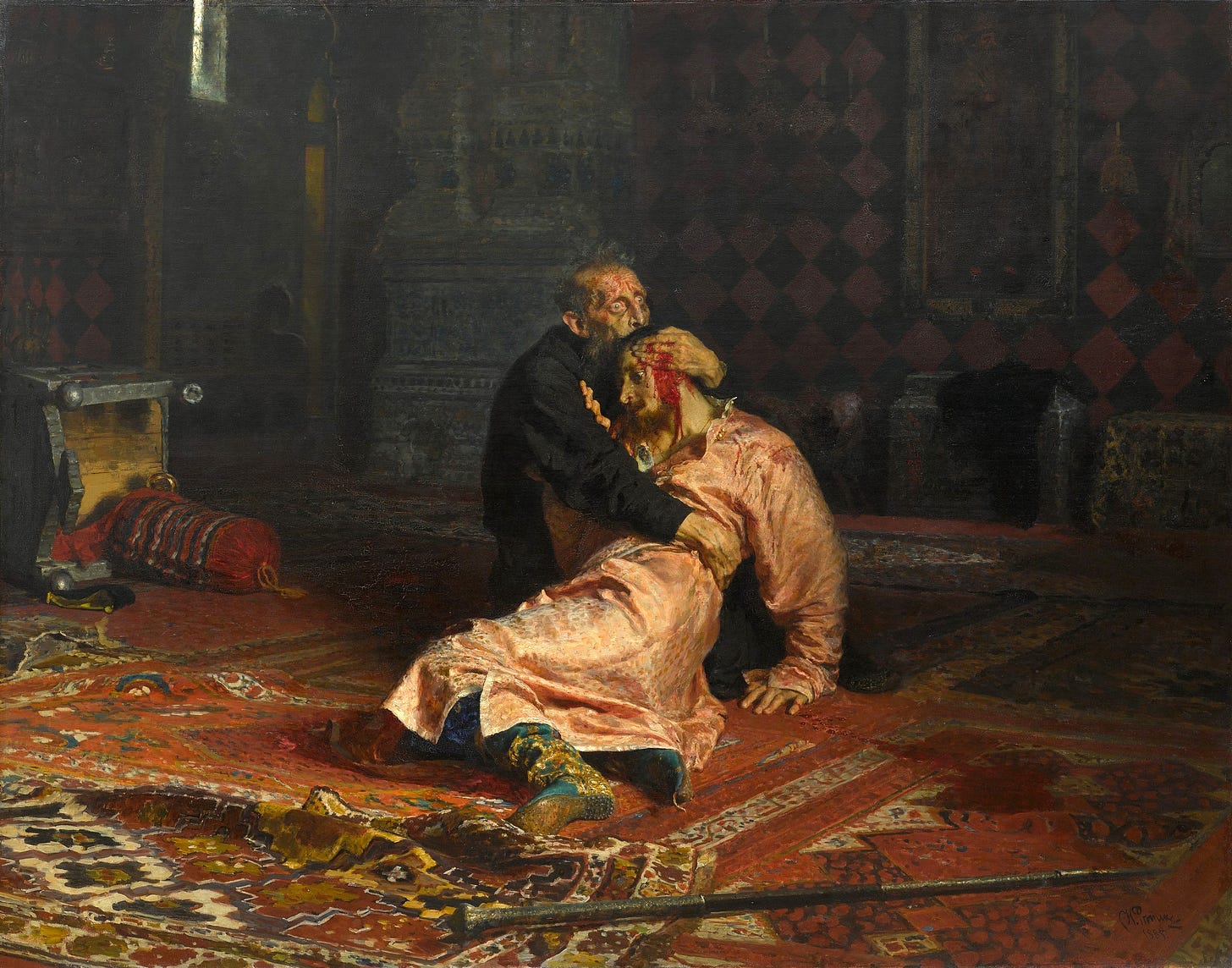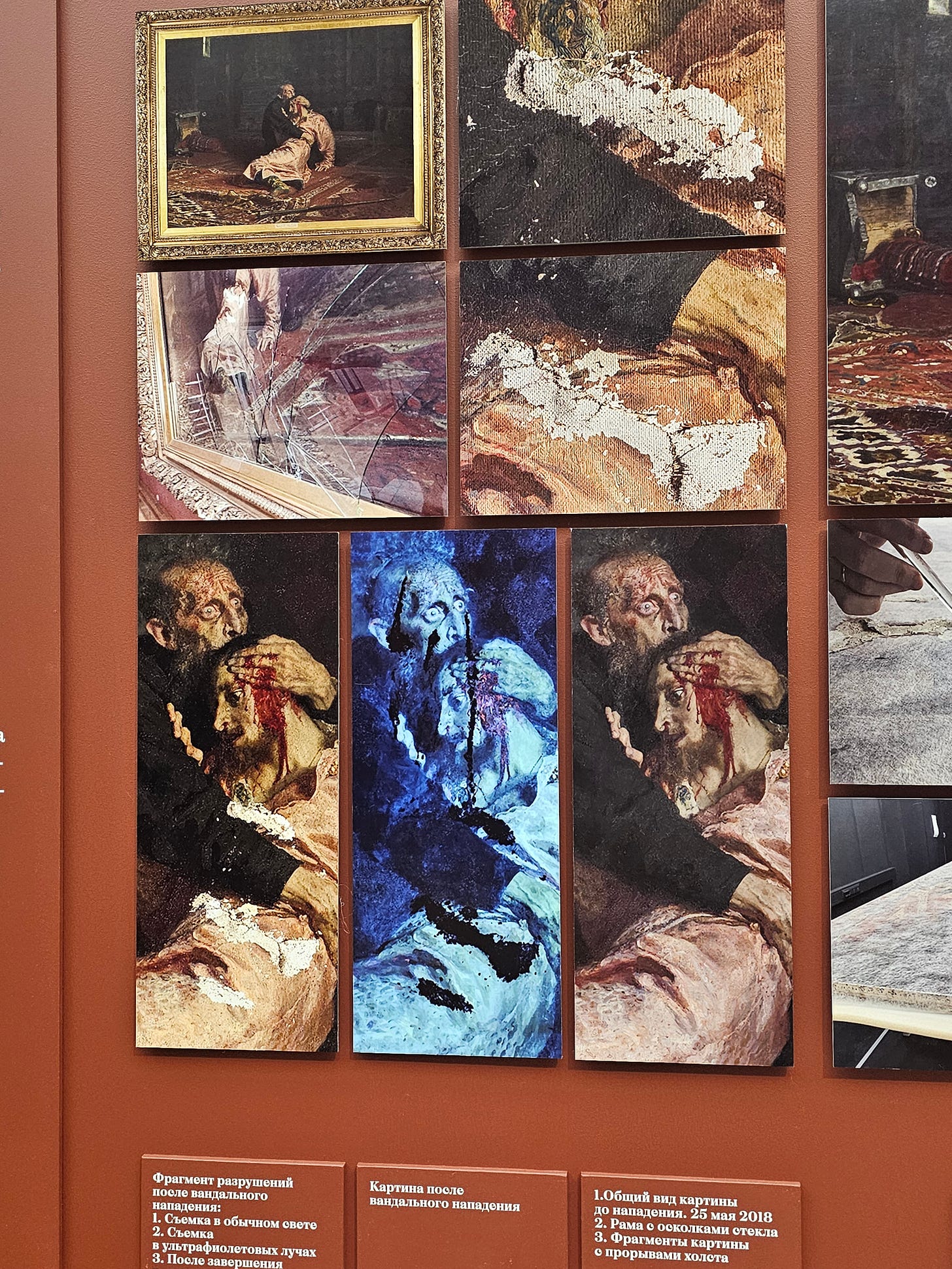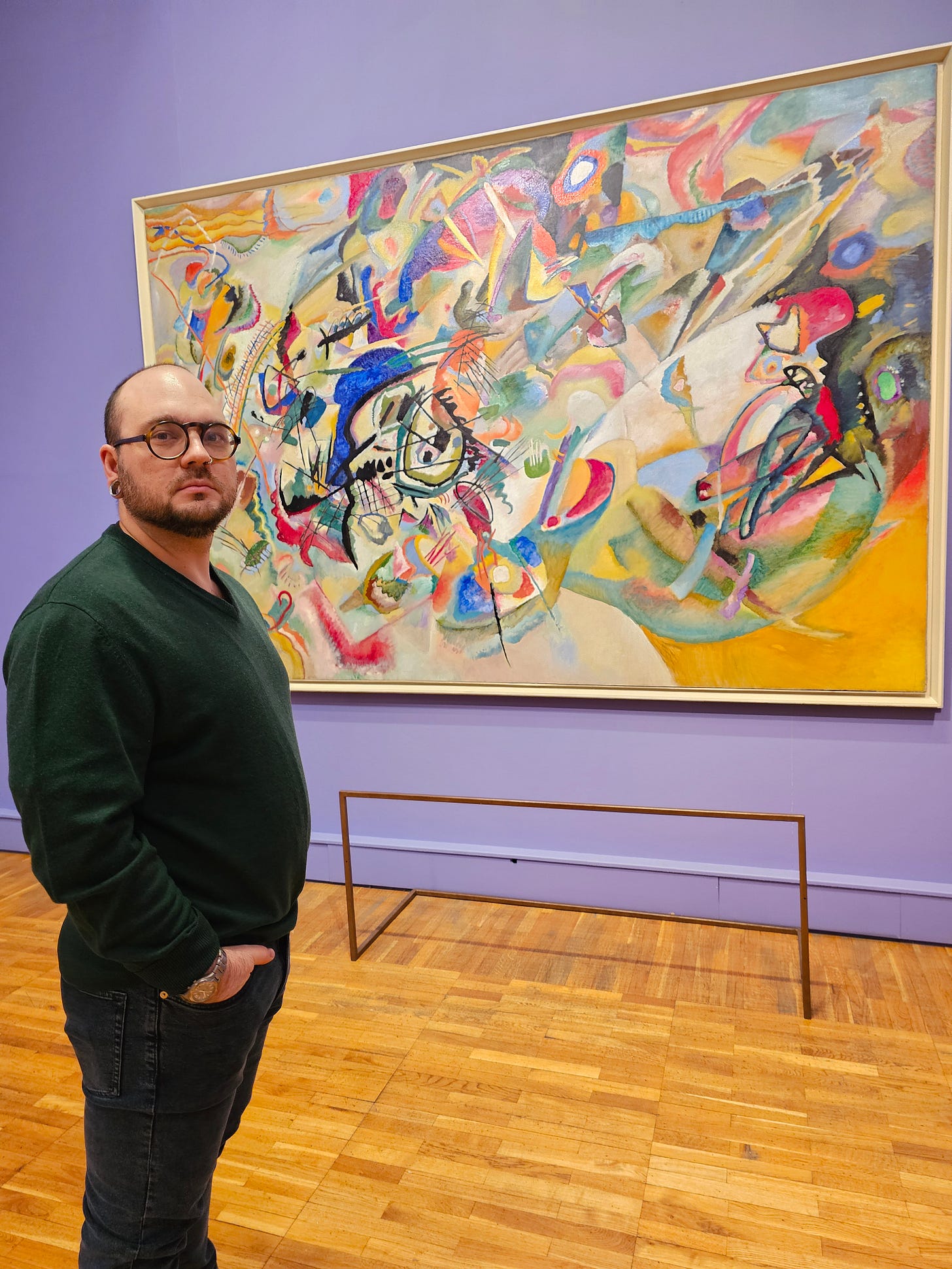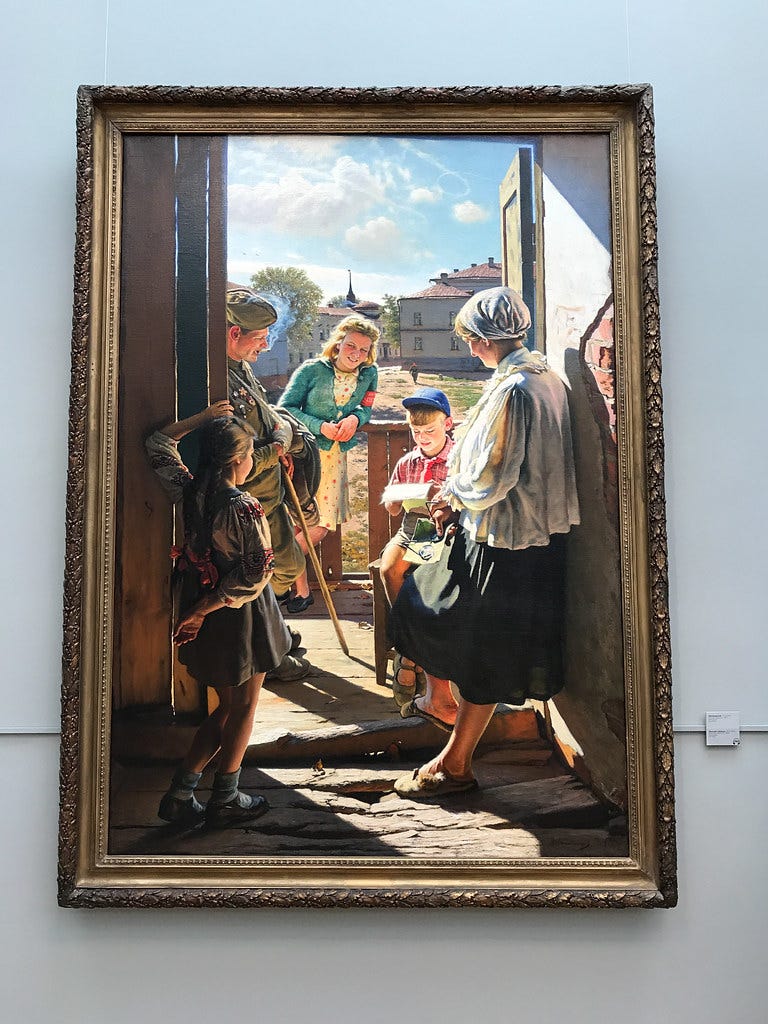Russian Diary #3: A VISIT TO SEE RUSSIAN AVANTGARDE ARTWORKS WITH MY WIFE WHO HATES ABSTRACT ART.
My wife and I argue over realism vs abstract artworks, reflections on tattoos and symbolic meaning, and the story of the attack on Ilya Repin's Ivan the Terrible and His Son Ivan.
In Moscow, there are two art galleries called Tretyakov. The new Tretyakov Gallery occupies a bank of the Moscow River, not far from Gorky Park. Alyona and I went there after a morning spent again at the dentist. We left the dentist and travelled underground to the metro station that would take us closer to the art gallery. As we moved through the crowds I asked again for details of Alyona’s dental work. She often doesn’t know exactly what will happen until she’s in the chair, and even though she has explained what has been done several times I cannot faithfully reproduce here any explanation.
A day earlier, we had visited the original Tretyakov Gallery, which contains artworks from the early religious periods of Russia to the nineteenth century masters of realism and romanticism. This is Alyona’s preferred gallery. We walked slowly from room to room, encountering Ivan Kramskoi’s Portrait of an Unknown Woman, Valentin Serov’s Girl with Peaches, Morning in a Pine Forest by Ivan Shishkin & Konstantin Savitsky, The Unequal Marriage by Vasily Pukirev.
The Unequal Marriage, Vasily Pukirev, 1862
Alyona admires the skill in representing the real in such detail; she admires the labour, the craft, the precision, that is demanded by realism more than perhaps the ‘vision’ or conceptualisation that dominates art after the crisis of photography. My really basic understanding of this paradigm shift is that the technological invention of photography caused an identity crisis or crisis of relevance for the painters and artists who had largely traded off mimesis. So their reinvention involved conceiving of art as a particular ‘vision’ that is separate or at least differentiated from its representations of the real world. It started to use ‘reality’ as the raw material for artistic vision . . . how am I going so far?
Anyway, Alyona always pauses the longest to examine the dramatic seascapes of Ivan Aivazovsky, the romantic who loved Crimea and the Black Sea. I had only heard of Aivazovsky when Alyona took me to Hermitage in Saint Petersburg in the Russian summer of 2024 and I now believe that no one conveys tempest and waves and foaming sea and the interplay of sea and sky better than him.
Aivazovsky’s Rainbow, 1873
So prominent are Aivazovsky’s representations of the sea in my mind that when we saw the Barents Sea in Teriberka, where the waves broke against black prehistoric stones I said they reminded me of an Aivazovsky painting.
The other notable experience at old Tretyakov was Ilya Repin’s famous depiction of Ivan the Terrible and his son Ivan, which is called Ivan the Terrible and His Son Ivan on 16 November 1581. This painting reminds me of Goya’s black paintings, particularly Saturn Devouring His Son.
Ilya Repin, Ivan the Terrible and his Son Ivan, 1885
We were lucky to see Repin’s painting of Ivan the Terrible and his son at all. It has a long history of being defiled and assaulted by iconoclasts and people who are affronted by its controversial yet seemingly authoritative historical representation of Ivan as the murderer of his own son. It was returned to Tretyakov on 16 December 2024, not even two weeks before we visited. On the adjacent walls were images and text explaining the process of restoration.
Restoration work on the Repin after it was attacked in 2017
The 2017 attacker was a man in his thirties from Voronezh who was visiting Moscow. The man came to Tretyakov Gallery, visited the café and drank 100 mls of vodka, then went to see Repin’s painting at which point he ‘became overwhelmed by something’ and used one of the security poles to smash the protective glass and damage the painting. There is a long-standing dispute about the historical accuracy of Repin’s painting: it claims very firmly that Ivan the Terrible killed his son but this isn’t clearly supported by the historical record and may indeed be an exaggeration, even though it makes for a much more dramatic story. Although I despise the man’s behaviour, I love this numinous or spiritualised idea of possession in his police report—him being possessed or overwhelmed by ‘something’. Could it be the vengeful spirit of Ivan Vasilyevich trying to redeem his legacy?
While Alyona prefers the old Tretyakov Gallery, I’m a disciple of The New. The New Gallery contains the artworks of the Russian avantgarde and also the Soviet-era relapse into socialist realism, which was of course heralded by the state as the final manifestation of ideal artistic expression. (It wasn’t.)
The New Tretyakov Gallery is a fortress-like slab of concrete across the road from the neoclassical arches that adorn the entrance to Gorky Park. The building design is plain, ugly, austere; I like it. Outside the gallery is the monument graveyard I wrote about in the first Russian Diary post.
When we arrived on Wednesday 25 December, a day that is not Christmas in Russia, it was about midday and the gallery was desolate. Unlike the Old Tretyakov with its lines and crowds and the jumpscares of people hovering right behind you holding those pull-yourself-out-of-reality guide phones to their ears—there were hardly any visitors. We put our coats and my backpack in the coatroom then took the stairs to the fourth floor where the permanent exhibitions reside and are organised chronologically. This means, in a cute irony, the first exhibit of about twenty rooms is devoted to the Russian avantgardists. Here are the so-called self-proclaimed vanguards who saw themselves in the early 1900s breaking away from tradition and innovating totally new styles, moving artistic expression onwards into the future—and they’re the first reference point in the gallery. Poor darlings.
Kazimir Malevich’s Suprematist Composition, 1916
As we passed through each room, Alyona’s exasperation increased. These artworks are not beautiful to her. She expressed a particular incredulity at two artists: Kandinsky and his pure abstract vision and Malevich’s Suprematist Composition & The Black Square.
Malevich’s Black Square is, as the name suggests, a painting of a black square. It’s given a similar ‘revolt against tradition’ status to Duchamp’s Fountain, which is not as the name suggests an actual fountain but is a urinal. What makes Black Square significant isn’t its aesthetic qualities—anyone, arguably, could paint a black square on a canvas. It becomes less about what was literally presented and more about what it represented—that is, the anti-real.
Given my casual interest in art, I won’t embarrass myself with attempts at trying to further decode the mysteries of Russian avantgardism. Because despite all the cerebralism around the artworks, the truth is my enjoyment of abstract art remains primarily aesthetic.
Let me explain further by way of digression.
Some of my tattoos have symbolic meaning, but most of them don’t. ‘Tell me about all the eyes,’ someone asked me once, although the directive was bereft of question mark or upwards inflection, it was a command, I realise now, as though bearing ink upon your body mandates that you must always explain yourself when asked. ‘Huh, never noticed,’ I replied. As I’ve been reflecting on this little nothing from my past, I have looked over my body. I have eighteen eyes tattooed on my arms and legs; this was not by design. There may be some more eyes somewhere—I can’t see all my tattoos anymore.
The rose on my hand means nothing. It is a pretty rose that I like. It’s a generic idea for a tattoo—maybe I should call it ‘classic’ (sounds better than unoriginal). It’s so generic that I asked my tattoo artist to draw the rose on my hand and wrist with a marker then to tattoo it upon me directly without a stencil; I trusted that whatever he made would resemble what I hoped, or maybe I had the tattoo done without specifications. Maybe I knew that whatever he tattooed I would like, because, even if there was some awkwardness in the composition, it was mine.
Many of my tattoos do not resemble something beyond their aesthetic or a personal affinity for the images that does not migrate well from the emotional world to the world of language. My tattoo artist, who I have not seen for a couple of years now, used to complain bitterly about the frequency with which strangers at parties or bars would ask him to explain the meaning behind, say, the exploding voodoo head covered in purple blood on his bicep, or the wolf tattooed on his neck or the upside-down cross beneath his eye. ‘I got them,’ he would shout, ‘because they look fucking sick.’ My tattoo artist was always better with images than words, but he does get the point across.
The idea that Malevich’s Black Square (a painting I find aesthetically indifferent) or Kandinsky’s various abstract compositions (far more fun to look at!) symbolise certain interventions in artistic tradition doesn’t particularly interest me more than looking at how these Russian future-gazers were working their colours and geometrical shapes a hundred years ago and their paintings still, somehow, look futuristic. How is that possible? Some of Malevich’s suprematist compositions remind me of rockets and missiles, but they were produced years before the formal innovations of rocketry. I think it’s because these shapes and images without stable structure allude to a desire or yearning for the future without actually portraying the specifics of this future. It is maybe what Raymond Williams meant by a structure of feeling, contained within this explosion of new styles with all the attractive and/or repulsive dick-swinging and elitism of the modernists.
The author, with a Kandinsky artwork, in a purple room, reflecting on the fact that Kandinsky started becoming a serious painter in his thirties, so there’s still hope for us
Anyway, it’s all very exciting, but anyone with a bit of twentieth-century history knowledge will know that 1915 was perhaps not the best timing for a revolution of artistic expression, given that a different revolution was about to be underway, one that converted the fledgling avantgardists, who had only just woken in their nests and begun to chirp, away from their decadent ways.
The Russian artists reach their most conceptually daring, their most antirealist, their most ‘pure’ art—then you turn a corner into a new exhibition hall and are greeted by colossal, severe realist portraits of Iosif Stalin in military attire upon the walls of the Kremlin. What followed were a series of incredibly beautiful but for me (not so much for Alyona) less inspired works. They demonstrated that skilful photorealism that was previously considered obsolete or at least less valuable post-photography.
Alexander Laktionov, Letter From the Front, 1947
It’s wrongheaded to say that Stalin turned art into propaganda; clearly the Malevich and Kandinsky had agendas for their artworks. They were clearly using their artistic representations to send messages to the public about the possibilities of art. To say that socialist realism was a form of state-sanctioned propaganda, then, is both correct but also banal.
And yet, I felt saddened by the return to realist modes enforced by the Soviet regime.
I will tentatively pose a somewhat lateral connection between avantgarde styles and writing in an effort to explain my own openness to abstraction. First, in my own writing, I feel like I’ve done a similar about-face as the Russian artistic traditions of the twentieth century. I wrote a novel in a kind of satirical maximalist mode, full of incredible occurrences, discontinuous plotlines, Big Long Sentences and Big Long Words. Since then, I’ve been practising a neater style, one that aligns more with conventional realism. It means I can see the work more clearly. And hopefully the reader can see the craft clearer too, because the vision has been all tidied up.
If anyone made it this far, thanks for reading. I’ll leave it here for now. In the next entry I’ll be reflecting on the holiday period, discussing Russian food and celebrations and also nostalgia for the days of the Soviet Union.
When we left the gallery, the snow had melted. We went to Gorky Park but it was depressing and empty and dirty and many sections were closed for repairs or rendered impassable by ice and slush.
I had finished this post and intended to send it off, but there’s one more visitation worth mentioning. In our travels around Moscow, we visited the Trinity Lavra of St. Sergius in Sergiyev Posad, a lavra founded in the fourteenth century and where Alyona’s godmother now lives and works. Her name is Galia and she is a devout disciple of the Orthodox faith. Although we had gone there as ‘tourists’, I suppose, the lavra is not a place for tourists. It was busy, full of worshippers, who would line up outside the many cathedrals to worship the icons and say their prayers and light candles to the saints. Because of Galia’s establishment at the lavra, we were able to cut through queues of hundreds of people to enter the cathedrals. I had not quite readied myself for the duties inside the cathedrals, which involved forming the sign of the cross with your right hand and three fingers and also bending down to kiss the icons in certain pre-ordained locations. Occasionally the icons had glass cabinets and I knocked my forehead quite hard against them and the sound of me headbutting a sacred icon echoed resonantly through the cathedral.
Rublev’s Trinity, recently relocated to the Trinity Cathedral against the wishes of Tretyakov Gallery
In one of the cathedrals, Galia told us there was a famous icon by Andrei Rublev called Trinity. As I wrote this post I was thinking about ways to incorporate this interesting anecdote of Russian art history, but couldn’t find a natural place for it. But life has offered it anyway.
Rublev’s Trinity lived in the Tretyakov Gallery for many years until Vladimir Putin ordered that it be returned to the lavra. This was a controversial move: the gallery director refused the order, but then the religious icon was forcibly removed from the gallery. A couple of years ago Trinity was returned to the Trinity Church, where I saw it, in the dimlit cathedral, devoid of spotlight, blurred by the smoke of incense and worship candles, restored to its original purpose.












Джек, очень интересно твое видение и понимание русской культуры. Жду следующих постов!